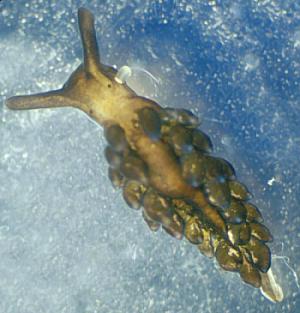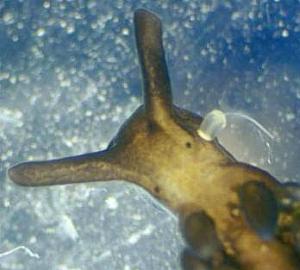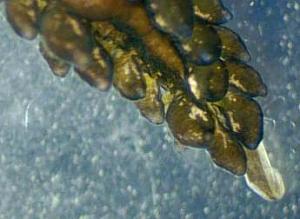
Aplysiopsis minor
(Baba, 1959)
Order: SACOGLOSSA
Superfamily: LIMAPONTIOIDEA
Family: Hermaeidae
PHOTO
Miura Peninsula, Japan. 13 mm long, 16 May 2000. Photo: Yoshi Hirano.
See Cynthia Trowbridge's message below.
See Kathe Jensen's message suggesting the identification is probably incorrect.
Reference:
• Baba, K. (1959) The family Stiligeridae from Japan (Opisthobranchia - Sacoglossa). Publications of the Seto Marine Biological Laboratory, 7: 327-336.


Rudman, W.B., 2000 (September 24) Aplysiopsis minor (Baba, 1959). [In] Sea Slug Forum. Australian Museum, Sydney. Available from http://www.seaslugforum.net/find/aplymino
Related messages
Re: Aplysiopsis minor from Sagami Bay
May 19, 2007
From: Cynthia Trowbridge
Concerning message #4304:
Dear Bill and Kathe,
When Kathe made her comment in 2001, I was surprised because I had not seen any stylet in the live animal and the dorsal view did not fully illustrate the rhinophore shape. I was certain that the "stylet" was merely a scratch on the plastic petri dish.
My delay in answering this message was that the photographed specimen was not kept so we needed to collect more specimens from the same pools in the same season. We eventually did find several more specimens. The radular teeth were indeed sabot-shaped. Thus, I do believe that our specimens are Aplysiopsis minor, including the original one.
Thanks for your patience on this one.
Cordially,
Cynthia
trowbric@yahoo.com
Trowbridge, C.D., 2007 (May 19) Re: Aplysiopsis minor from Sagami Bay. [Message in] Sea Slug Forum. Australian Museum, Sydney. Available from http://www.seaslugforum.net/find/19922Dear Cynthia,
This is a good example of how taxonomy sometimes takes awhile to progress when animals are not available. Not being an expert on these animals I had a look at Baba's description and some of Kathe's papers to clarify in my own head the distinction between Ercolania and Aplysiopsis - the two genera with sabot-shaped teeth. I hope Kathe, that things haven't changed (Jensen, 1993), but you differentiate these two genera by a number of characters. The rhinophores are 'rolled or folded' in Aplysiopsis but never in Ercolania. The penis in Ercolania has a short curved stylet but in Aplysiopsis it has a long flagellar extension, and while Ercolania has albumen gland branches in the cerata, Aplysiopsisdoes not.
If these characters are correct I am not sure what this animal is. Kathe describes the penial papillae as a 'thin curved stylet' [= Ercolania] but could it be a 'long flagellar extension' [= Aplysiopsis]? As to the rhinophores I think we need some more information - I can't tell from the dorsal photos whether they are 'rolled or folded'. Which brings us to the albumen gland branches. Are the white branches on the cerata pigment marks or are they internal ducts? I note that Baba specifically says there are no albumen branches in his animals.
Cynthia, can you tell us more about the rhinophores and the albumen gland? If so we might be able to end this 6 years and 1 week discussion - not that it isn't enjoyable of course.
-
Jensen, K.R. (1993) Sacoglossa (Mollusca, Opisthobranchia) from Rottnest Island and central Western Australia. In: Proceedings of the 5th International marine Biological Workshop: The marine Flora and Fauna of Rottnest Island, Western Australia. (Eds: Wells, F.E; Walker, D.I; Kirkman, H; Lethbridge, R) Western Australian Museum, Perth, 207-253.
Best wishes,
Bill Rudman
Re: Aplysiopsis minor from Sagami Bay
May 11, 2001
From: Kathe R. Jensen
Dear Bill, Cynthia & Yoshi,
Having a few holidays before the new term starts, I was searching through some old messages, and found this one of "Aplysiopsis minor". However, this animal seems to have a thin, curved penial stylet, which does not occur in the genus Aplysiopsis. Also, it seems to me that there is a white branching tubule in the cerata in addition to the digestive gland tubules. My guess is that this is the albumen gland, which also does not enter the cerata in Aplysiopsis. In the original description Baba distinctly figures the typical denticulate, sabot-shaped radular teeth of Aplysiopsis, so I think that this specimen was simply misidentified, and that it is more likely a species of Placida (because of the auriculate rhinophores) or Ercolania (in which case the rhinophores should be ventrally grooved, but not auriculate). To get a definite ID we need to look at the radular teeth - blade-shaped in Placida and sabot-shaped in Ercolania.
Greetings,
Kathe
jensen@ait.ac.th
Jensen, K.R., 2001 (May 11) Re: Aplysiopsis minor from Sagami Bay. [Message in] Sea Slug Forum. Australian Museum, Sydney. Available from http://www.seaslugforum.net/find/4304Thanks Kathe,
I guess I will leave it as Aplysiopsis minor until we get some information on its radula. It seems nothing is simple....
Bill Rudman
Aplysiopsis minor from Sagami Bay
September 25, 2000
From: Cynthia Trowbridge

Dear Bill,
Here is another of the sacoglossans that Yoshi Hirano kindly photographed for me in Sagami Bay, during this past May. It is Aplysiopsis minor (Baba 1959) (Hime-kuro-moumiushi)
This animal coexists with Ercolania boodleae in high intertidal rock pools. The species is pigmented black. One of the key characters is that the sole of the foot is yellowish white with two longitudinal black bands extending the length of the foot; another species (Aplysiopsis toyamana) has two longitudinal black bands that extend from tail to center of foot (Baba 1959). We found 6 specimens on 16 May 2000 on the Miura Peninsula, Japan; our specimens were up to 13 mm long. Gonor (1961) distinguished Aplysiopsis enteromorphae (as Hermaeina smithi) from A. minor and other congeners.
References:
• Baba, K. (1959) The family Stiligeridae from Japan (Opisthobranchia - Sacoglossa). Publ. Seto. Mar. Biol. Lab., 7: 327-336
• Gonor, J.J. (1961) Observations on the biology of Hermaeina smithi, a sacoglossan opisthobranch from the west coast of North America. The Veliger, 4: 85-98.
Best wishes,
Cynthia.
trowbric@ucs.orst.edu


Thanks Cynthia,
Bill Rudman.
